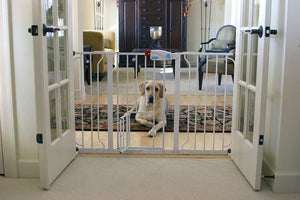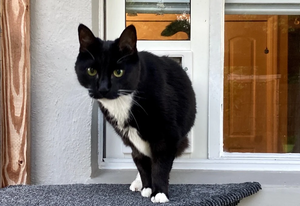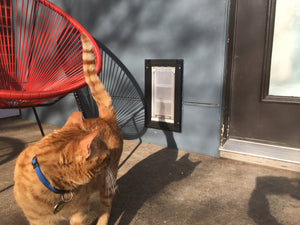How to Train a Dog Not to Bite Strangers
 Experiencing problems with your dog lashing out or biting new people that come into your home? As scary as this seems for whoever experiences your dog's bad habits, dog biting is not uncommon among most dogs. However, an aggressive dog is most likely reacting out of fear or territorial dominance. Of course, we don’t want our furry friends to act this way, but most of the time the biting is instinctual. In order to train dogs not to bite, owners must understand several things about their dog and their aggression.
Experiencing problems with your dog lashing out or biting new people that come into your home? As scary as this seems for whoever experiences your dog's bad habits, dog biting is not uncommon among most dogs. However, an aggressive dog is most likely reacting out of fear or territorial dominance. Of course, we don’t want our furry friends to act this way, but most of the time the biting is instinctual. In order to train dogs not to bite, owners must understand several things about their dog and their aggression.
Determining the Cause
To know how to train your dog not to bite and begin bite training, you need to first understand the root cause of your dog's biting behavior.
For some dogs, aggressive behavior begins as a part of rough play during puppyhood. According to animal behaviorists, bad behavior in adult dogs can originate in nibbling, nipping, and teething habits among littermates. Puppy biting can be taken care of by providing chew toys and enforcing time-outs outside or in a kennel when your puppy bites. This will help reinforce good behavior. Some pet owners even found that teaching your dog bite inhibition (mouthing instead of biting into human skin) is an effective method of impulse control and gentle play for dogs.
However, bad dog behavior may have more serious origins. It is important to rule out any outside factors, such as medical conditions or illnesses. If your dog was not a biter before but suddenly becomes aggressive when touched, it may be possible that there is an underlying injury or sensitivity that is causing the aggressive behavior. Lashing out due to pain is not uncommon, so make sure to take your dog to the vet for a checkup to rule out any possible medical issues that could be causing the aggressive activity.
If your dog’s body language is characterized by a submissive stance, tucking the tail, crouching, and lashing out to bite from an angle, then your dog is acting out due to fear. A dog that bites out of territorial aggression will most often hold a dominant stance, bark, and make eye contact.
For both cases of biting, this usually stems from a lack of socialization as a puppy. Puppies need to be exposed to a lot of different people at a young age in order to be adult dogs who trust in humans. This is especially important for breeds that are bred to be protective by nature. Giving puppies copious interactions with humans is the best preventative measure for biting out of fear and/or aggression. Lack of socialization can also occur in dogs who have been in shelters for long periods of time with limited human interaction, as well as in dogs who have been mistreated by previous owners.
Training Methods
There are three different methods that you can practice in order to begin training a dog not to nip at strangers. Acclimate your dog to new people in your home. If your dog is older and is exhibiting aggression, it is best to consult a professional dog trainer, as this will ensure that the behavior is managed in the timeliest manner possible.
1. Establishing Leadership
Making sure that your dog knows that you are in charge is the first step to take. This way, your dog views you as the dominant “pack leader”, in which case you are in charge of situations where strangers are present at your home. This is best to practice in outdoor settings, especially when walking your dog. To establish authority, teach your dog to “heel” and follow you on a leash.
Once this is mastered, arrange to have a friend that your dog isn’t familiar with to approach you on a walk. Stay calm and exert positive energy as you practice the “heel” technique, rewarding your dog for good behavior. If you are worried that your dog may get too aggressive, using a muzzle or head halter can be used to ensure the safety of your friend. When your dog reacts aggressively toward your friend, pull the leash quickly to the side or in an upward motion. Tap them on the side with your leg as you are redirecting their movement, ensuring that they are aware that you are making the decisions about the stranger. Have your friend proceed by and continue on your way, using the “heel” command as you do so.
Practice this over a few weeks until your dog understands that you are in control. Make sure to exhibit positive reinforcement; negative punishment will not reinforce good behavior and will only exacerbate behavior problems.
2. Desensitizing
Ask a friend who is not familiar with your dog to come to your home, as your dog will feel less anxious in this environment. Put a leash on your dog in order to ensure that you can help prevent any biting. Use a head halter if necessary. Have your friend approach slowly, and instruct them to stop and wait when your dog starts to get aggressive or show signs of fear.
Once your dog has relaxed a little, reward their calm behavior with affection and treats. Repeat this again, instructing your assistant to move closer each time, but at a side angle so that your dog does not think it is a threatening stance. Once your dog has calmed down again, allow your friend to toss treats in order to inform your dog that the stranger does not mean any harm. Repeat this over a few days/weeks with different friends until your dog does not show aggressive or fearful behavior.
3. Alternate Behavior
Teaching your dog to “lie down” and “stay’ is ideal for preventing biting, as it reduces the chances of your dog confronting the stranger without your permission. Start by teaching your dog these commands inside your home. Use treats as a reward to establish positive reinforcement.

Once your dog has mastered the technique indoors, repeat the process outside. Use the “lie down” and “stay” commands when something distracting occurs, such as seeing another animal. When your dog listens, reward them with a treat.
Once this becomes a reliable command, incorporate a friend with whom your dog is not familiar into the mix. Make sure your dog is on a leash to ensure safety. Instruct your friend to slowly approach your dog when they are already in the “lie down” and “stay” position. If the position is broken, tug on the leash and repeat the command until your dog obeys and calms down. Reward them with a treat for calm behavior. Then repeat the process again, practicing several times a week until your dog is fully acclimated.
Best Practices
As a note, it is always important to inform strangers, especially ones who are entering your home or yard, about your dog’s cues and preferences prior to introducing them to each other. During first introductions, have the stranger refrain from putting out their hand to let the dog sniff. They may be inclined to bite it. Let the dog come to them to do the sniffing. Dogs are protective by nature, so make sure to have patience when training your dog not to bite, and reward your pet for growth and success.
Learning how your dog behaves around strangers and family directly translates to how to train your dog to stop biting people!
References:
https://wagwalking.com/training/not-attack-strangers
https://wagwalking.com/behavior/why-dogs-bite-strangers





Hi Sam,
Your puppy may be nipping at some people out of fear. Positive reinforcement is a great tool here.
Take your puppy out as often and when someone new walks past, give a small treat or use a clicker or marker word to create a positive association with all types of people.
I hope this helps! If you have any questions about pet doors, feel free to call us at 1-800-826-2871 or email customerservice@petdoors.com anytime.
Happy New Year!
Happy New Year!
MY 8 MONTH PUP (A RESCUE) IS VERY DOG AND PEOPLE FRIENDLY BUT WILL OUT OF THE BLUE NIP AT SOME PASSING PEOPLE.
Hi Steve,
I would recommend contacting the shelter where you adopted your puppy from to see if they have training tips or recommendations for local behaviorists who can help with this issue.
Happy holidays!
Hi Rachel,
I’m very sorry to hear that Josie’s two brothers passed on, I know how heartbreaking that is. It sounds like Josie got used to the protection of her older brothers and without them she is feeling uncertain about her surroundings.
I agree that the new puppy will help her feel more secure and less reactive. Even though Josie was well-socialized, it’s a good idea to repeat some positive reinforcement training to remind her that her surroundings are not a threat.
For instance, you can sit out in a public space with her and give her a yummy treat every time a runner, biker, etc crosses your path. Bringing your new puppy along will help as well so that Josie can see that her new friend is not reacting and that she is safe.
I hope this helped answer your question and wish the best for Josie and her new buddy!
Happy holidays!
We have a little 10 year old dog named Josie. She is a Chinese Crusted, Schnauzer mix.
When we take her for a walk she wants to chase people on bikes, joggers and nip ankles of anyone trying to walk by.
She wasn’t always like this, she was well socialized. She was raised with two older Schnauzer brothers. They became very protective of her. They would not come in till she did. Sadly and with a broken heart they both past on in a span of two years. Now she has become nippy at strangers, joggers, bikers.
We adopted a little carein Terrier a few weeks ago. We’re hoping a new friend will help her.
Any advice you can give would be greatly appreciated. Thanks
I have a rescue Shi Tu, and York’s .mix. As a pup he was kept in a crate for 8 months never let out and only fed people food. He was fostered for a Year before I adopted him. I have had him die 8 months. He is a sweet and loving dog. Problem is he is over protective of me. He has snapped at my family. And to night when I was correcting him he bit me broke skin. I know alot of this is his past, But he has been here for 8 months. I need to stop this asap.
I have an 8 month old king shepherd. He was a rescue. He’s very skittish and when people pet him, sometimes he’s ok and other times when the person stops petting him and turn to walk away, he lunges at some and nips at them. Please help with this.. Thanks in advance
How to stop dog attacking people and kids. I fixed my gate. And considering on neutering.
My 3 year old German Shepard Red heeler mix keeps biting people who come in the house, we suspect he was abused by a previous owner, and since my mom and I are usually busy we don’t have time to train him, if anyone knows anything I can do please let me know because none of the dogs training schools will do in person training with him which is what we need
Have had numerous collies only found out they don’t like been overprotective though when they get scared some tend to bit it’s possibly there own auto defensive system kicking in some reassurance it’s usually helps
hi I have a 7 year old female Romanian rescue, don’t no to much of her background but has nipped someone when she came near her an her new human mom, her teeth was showing an she was like now nom nom, is this her being protective of her momma or is she weary of visitors or just anxious bout everyone 😋
I have a german sheppard that is great with us and very loving he is 4 years old since he was around two he has been getting agressive witb people can ne sat in house with someone then all of a sudden he will go for them then fter he looks so sad as he knows he shouldnt of done it please help
My 1 year old has several triggers. One if another dog is walking by our house he will try to bite because he is not getting his way to get to this dog. Also if we are outside he will bite my hands to let go of his leash because he is tracking something and wants at it.
When a dog bites strangers it is because it is scared and feels it’s job is to be the enforcer. If you establish authority when this happens… or in general, they won’t be filled with fear as they believe it is YOUR job to protect the ‘pack’ so to speak. You have to demonstrate authority and leadership to allow the dog to feel safe. In terms of having people round; if the dog is aggressive, then put them in a bluddy crate. It makes the dog feel infinitely safer.
Ensure the dog knows you are in charge and not them. It makes them feel so much safer.
My 11 month old German Shepard nips and usually bites new people he meets when they come near me. He is super friendly to me and to other people he has met before and has continuously seen. I just need some tips on how to fix this issue as we do travel a lot and are constantly going places where we see new to him people
Hi my name is Tonya Schwartz my dogs name is snuggles and he is one years old and I been having trouble with him nipping and bitting at people what can I do to get him to stop bitting and be the dog I know he can be he doesn’t bite me but he has nipped other people and where I live they have other dogs and he is good with my other 2 dogs but when I moved back in my ex’s mom he has been bitting and nipping at people but where I use to live they were mean to him is this a behavior I can break him from before it’s to late for him
Hi Jupitara,
We would suggest talking to a pet behavioralist to resolve this issue.
Hi Leonard,
You may want to talk to a pet behavioralist about this issue. They may be able to identify how to train your dog to react in a calmer manner.
Hey, my dog has bitten one of my cousin sister. Right now i m kinda feeling terrified as it happened right in front of my eyes and i couldn’t stop it. But before this event i heard that he had bitten one of y uncle and and try to bite my sister. i really want my dog not to bite anyone. my dog’s name is tobuchi, he was brought from one of my mother’s friend and we still don’t know his breed but they says he is local breed. my mother brought tobu when he was really small. It was when the quarantine was just begining. He is one year old now. Please please please help me tame my dog i really need your help right now.
I have a 6 yr old shepherd mix. He goes after anyone from quick movements and nips, or bites them. A friend that lives with us has been bitten a few times now. The friend cares for and feeds him daily. I need guidance on how to stop this aggression. Thank you